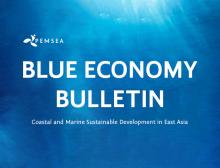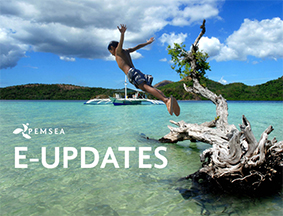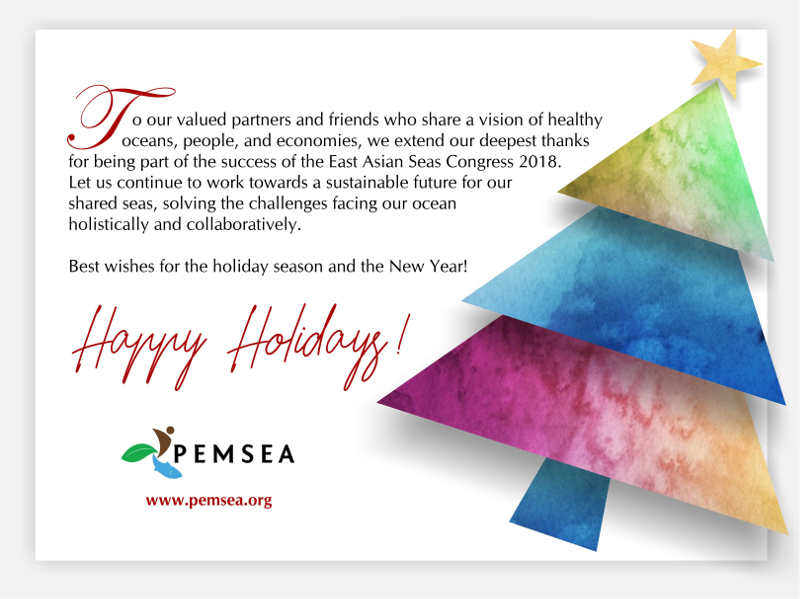
Breadcrumb
-
Blue Economy Bulletin August 2019
Welcome to PEMSEA's August Blue Economy Bulletin. This month PEMSEA looks at two coastal jurisdictions which lie along the seas of East Asia and are facing the challenge of ensuring development and growth occurs in a sustainable manner. Preah Sihanouk in Cambodia uses integrated coastal management (ICM) to conserve its environment and develop alternative livelihoods. Indonesia's Surabaya undertook a variety of complementary measures on waste management to tackle a daunting waste overload.
Other examples of sustainable coastal development can be found throughout the seas of East Asia. Kitakyushu in Japan faced development challenges half a century ago, and is now considered an eco city. The Philippine island of Samal has turned clams from a food source to an ecotourism attraction. Ca Mau in Viet Nam has seen the growth of organic farms that alternate between shrimp and rice in a manner that needs few potentially harmful chemicals. Singapore is preparing for a future with higher sea levels, expecting to spend over SGD 100 billion over the next century.
Climate change and the resultant rise in sea levels will mean that adaptation and mitigation will be needed on coasts around the world. Another consideration for coastal planning is land tenure, which can have significant impacts on how a community changes as it switches between economic models. Away from the coasts, ongoing negotiations look to establish regulations for managing international waters and for mining on the ocean floor.
Follow the latest updates on blue economy and coastal sustainable development in East Asia on Facebook and Twitter (@PEMSEA). We welcome your feedback, and please let us know if there are other blue economy topics you would like to see in future newsletters and programs.
-
E-Update July 2019
Welcome to the July PEMSEA e-update. Towards the end of July PEMSEA held the 11th East Asian Seas (EAS) Partnership Council Meeting, confirming new leadership that will guide PEMSEA in moving towards a vision of healthy oceans, people, and economies. The meeting had partners share updates in implementing the Sustainable Development Strategy for the Seas of East Asia (SDS-SEA) which closely aligns with the UN SDGs and other international commitments. They also discussed how the region has been delivering on science based scalable solutions since 1993 and viewed the upcoming UN Decade of Ocean Science for Sustainable Development as an excellent opportunity to share and exchange knowledge, experiences and best practices in linking science-policy and local action within the region and beyond. In between newsletters, follow us on Facebook and Twitter (@PEMSEA) for the latest updates.
-
Blue Economy Bulletin June 2019
Welcome to PEMSEA's Blue Economy Bulletin. This month, we released our annual report for 2018, which was a milestone year representing 25 years of PEMSEA's work on Integrated Coastal Management in the Seas of East Asia. Elsevier published a PEMSEA paper which describes the evolution of PEMSEA from a regional marine pollution project to an international organization working on integrated management solutions and partnerships and examines future key areas of intervention by PEMSEA. We also welcome a new project manager to lead the SDS-SEA in the future.
Over 100 countries have now signed on to the Port State Measures Agreement (PSMA), which increases the ability of countries to police IUU fishing. Ensuring fishing is sustainable requires increased knowledge of ecological connectivity between national fisheries and the high seas, something that will be aided by the further mapping of the sea floor. A draft text on a new UNCLOS agreement on managing biodiversity in international waters has been released.
The potential of using investments to make a difference has become clear as over $500 billion have now been put into impact investments globally. The Chinese Government is looking to expand the country's aquaculture industry. The Philippine Government has asked financial institutions to invest more in lower carbon projects. Banks involved in the shipping industry have agreed to a set of guidelines designed aid the lowering of shipping emissions.
Follow the latest updates on blue economy and coastal sustainable development in East Asia on Facebook and Twitter (@PEMSEA). We welcome your feedback, and please let us know if there are other blue economy topics you would like to see in future newsletters and programs.
-
E-Update May 2019
Welcome to the May PEMSEA e-update. This month saw the release of a significant and comprehensive report on the state of global biodiversity from the Intergovernmental Science-Policy Platform on Biodiversity and Ecosystem Services (IPBES). It paints a troubling picture, highlighting the gaps in current action and the challenges we face. Biodiversity is heavily affected by all manner of human activity, and in turn has a strong impact on the lives of people around the world. This e-update is focused on stories relating to biodiversity, beginning with good news on a coral replanting project in a PEMSEA ICM site. In between newsletters, follow us on Facebook and Twitter (@PEMSEA) for the latest updates.
-
Blue Economy Bulletin April 2019
Welcome to PEMSEA's second Blue Economy Bulletin for 2019. This month saw the launch of MEPSEAS, an IMO project aimed at addressing the impacts of maritime shipping on Southeast Asia's biodiversity. Initiatives are taking place to address biofouling, while Maersk leads the industry in combatting climate change.
Efforts to protect biodiversity were reflected elsewhere as Indonesia created 3 new MPAs in its waters. Biodiversity in international waters could be protected through an international requirement for environmental impact assessments, and an upcoming deep-sea mining pilot in international waters will be closely monitored to evaluate its environmental impact.
Spurring more sustainable development will require an overhaul of the global financial system, which will be difficult considering many institutions are not considering trends such as climate change in their financial accounting. Another key change to spurring sustainability would be unlocking data for the use of ocean management professionals.
Follow the latest updates on blue economy and coastal sustainable development in East Asia on Facebook and Twitter. We welcome your feedback, so please let us know if there are other blue economy topics you would like to see in future newsletters and programs.
-
E-Update March 2019
Welcome to the March PEMSEA e-update. This month has seen a number of tools released to aid with coastal and ocean management, some by PEMSEA partners and some by others. Find them below, alongside a selection of the latest news regarding our shared seas. We hope you join PEMSEA as we participate in Earth Hour this Saturday. In between newsletters, follow us on Facebook and Twitter for the latest updates.
-
Blue Economy Bulletin February 2019
Welcome to PEMSEA's first Blue Economy Bulletin for 2019. Top of our stories is an article on the economic value of wastewater as explained in the in-depth Indonesia, Philippines, and Viet Nam wastewater sector reports jointly published by PEMSEA and ARCOWA. The reports are timely and relevant given the region's focus on water quality, pollution reduction, and waste management. This month we also look at two integrated coastal management (ICM) examples featured in PEMSEA's 25th anniversary publication that showcase how cities build resilience to shocks and prepare to deal with climate change and other disasters.
As encouraging sustainability is a key plank in building a blue economy, it is important to understand the challenges faced by potential green investments in obtaining private financing. However, hope can be found in how dedicated climate financing is finding new avenues of cooperation, as the GCF and GEF announce a joint mission in Lao PDR. At a local level, a proper assessment of coastal areas is necessary to implement ICM solutions. CCRES has created 15 tools to assess fisheries management, business development, and other aspects of coastal management.
Seafood is one industry where achieving sustainability is essential, and innovative solutions appear to be thriving. Technology is helping, with acoustic sensors providing a novel method to detect blast fishing, while rapid DNA analysis may allow the species of fish parts to be identified within hours. The growing insect meal industry shows potential to become a reliable food supply for aquaculture. New research reveals better data about the state of Pacific shark populations, but also that microplastic pollution damages mussel populations, threatening their survival.
Follow the latest updates on blue economy and coastal sustainable development in East Asia on Facebook and Twitter. We welcome your feedback, so please let us know if there are other blue economy topics you would like to see in future newsletters and programs.
-
E-Update January 2019
Welcome to the first e-update of 2019! Towards the end of 2018 our Sixth East Asian Seas Congress saw delegates from throughout the region and the world congregate in Iloilo City to discuss how to secure healthy and sustainable oceans, people, and economies, and how to move as one with the global ocean agenda. Many of the proceedings from that event are now available.
Officially released during the Congress was our book Local Contributions to Global Sustainable Development Agenda: Case Studies in Integrated Coastal Management in the East Asian Seas Region. This contains case studies from throughout PEMSEA's 25 years. Read how two cases have improved ecosystem health.
Following cleanup and rehabilitation efforts in Boracay, an ambitious attempt to clean Manila Bay was launched late this month by the Philippine Government, led by the Department of Environment and Natural Resources. Internationally, efforts to reduce pollution spurred the creation of the Alliance to End Plastic Waste, whose members are global companies from throughout the plastic supply chain.
The importance of ensuring ocean use is sustainable was highlighted by China's huge increase in seafood consumption during 2018. Actions in the region to tackle illegal threats to biodiversity are having an impact, as China cracks a totoaba smuggling ring, while Indonesia looks to extend its anti-IUU fishing enforcement capabilities, and the Marine Stewardship Council works on potential changes to its fisheries evaluation such as taking into account shark finning.
Research on the impact of climate change continues, with new research suggesting that as the oceans reach the end of its thermal buffering warming will increase and sea level will rise 30cm this century. Current pledges fall short of what is needed to meet the Paris Agreement. In light of the growing impact of climate change, the World Bank is increasing finance for climate resilience. Lessons can be learned from the Indonesian response to the Sunda Strait tsunami, which was carried out through pre-existing capacity. -
End of Year Highlights!
Welcome to the final PEMSEA newsletter of 2018! The past year was a momentous one for PEMSEA, and for the shared seas whose future we are working to ensure. In this edition of the newsletter, we share some of the highlights from the work of PEMSEA this year, as well as important outputs produced.
We are proud with what has been done, however, expect more next year, which will see the continuation of ongoing projects such as the implementation of the Sustainable Development Strategy for the Seas of East Asia (SDS-SEA), as well as continuing outputs from the recent East Asian Seas (EAS) Congress 2018.
Next year we hope you will continue to share our vision of healthy oceans, people, and economies. Updates can always be found on our Facebook and Twitter (@PEMSEA) accounts. Happy holidays and a happy new year!


